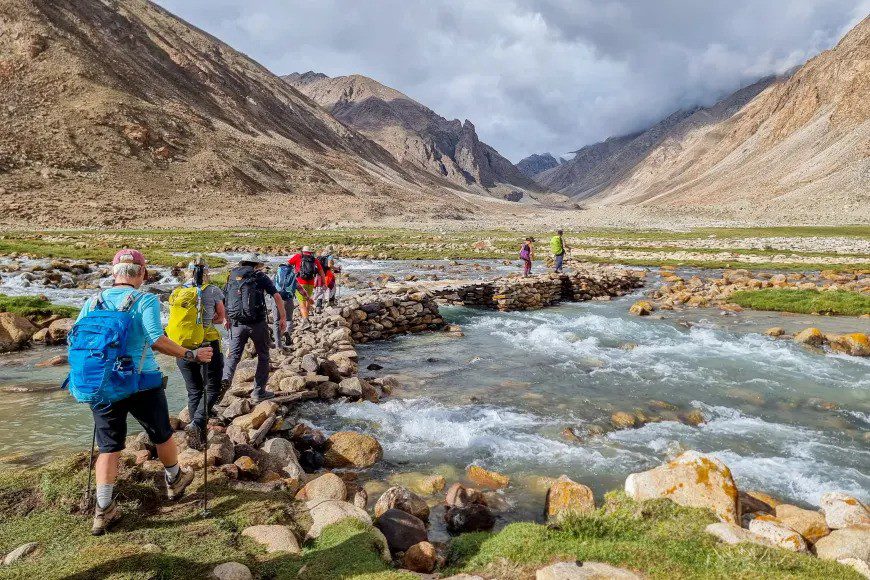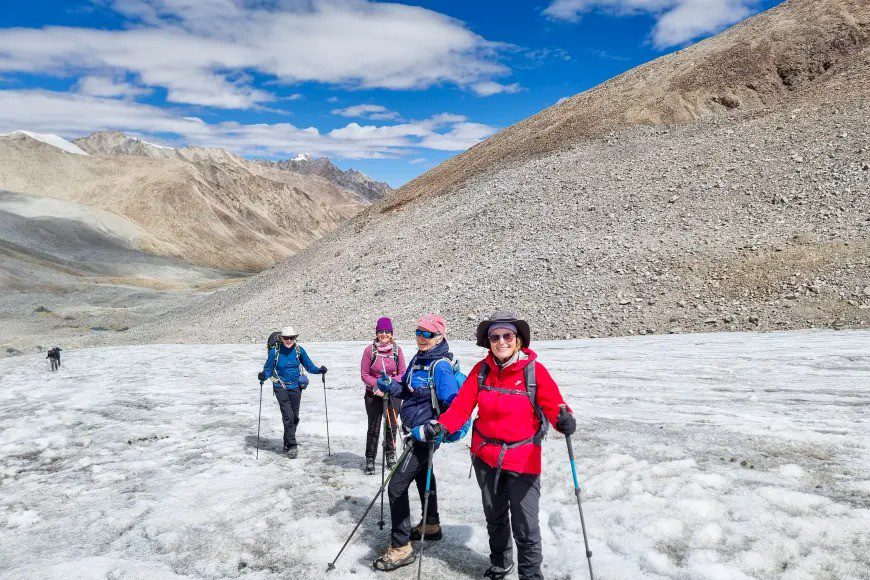Trekking the Nubra Valley offers an unparalleled journey through one of the most remote and breathtaking regions in Ladakh. Known as Ladakh’s “Hidden Oasis,” the Nubra Valley is an extraordinary fusion of stark deserts, lush green valleys, and the vibrant culture of ancient monasteries. For those seeking an offbeat adventure, this trek offers diverse landscapes, thrilling challenges, and cultural immersion in remote Himalayan villages. Whether you’re an experienced trekker or someone seeking new horizons, trekking Nubra Valley is a journey that stays with you long after your return.
Introduction to Nubra Valley – Ladakh’s Hidden Gem
The Allure of Nubra Valley: A Himalayan Oasis
The Nubra Valley is unlike any other place in the Indian Himalayas. Nestled between towering peaks and connected to Leh by the famous Khardung La Pass, Nubra Valley offers landscapes straight out of a dream. As you hike, you’ll witness the stark contrast of golden sand dunes, green oasis-like patches of farmland, and snow-capped mountains in the distance.
If you’re wondering why this is called Ladakh’s “Hidden Oasis,” just picture crossing a desert and finding a paradise of villages, monasteries, and fertile land, all surrounded by rugged mountain ranges. The valley’s unique geography, cradled between the Karakoram Range and Ladakh Range, makes it an extraordinary destination for nature lovers and adventurers alike.
Why Trekking in Nubra Valley Should Be on Your Bucket List
Trekking the Nubra Valley is a top choice for adventure seekers who want more than just a scenic hike. The cultural richness of the region adds layers of depth to your journey. As you trek, you’ll pass remote villages, interact with friendly locals, and witness daily life untouched by modernity. From exploring the iconic Diskit Monastery, with its colossal Buddha statue, to visiting the famous Hunder sand dunes for a camel safari, there’s more to Nubra than just its natural beauty.
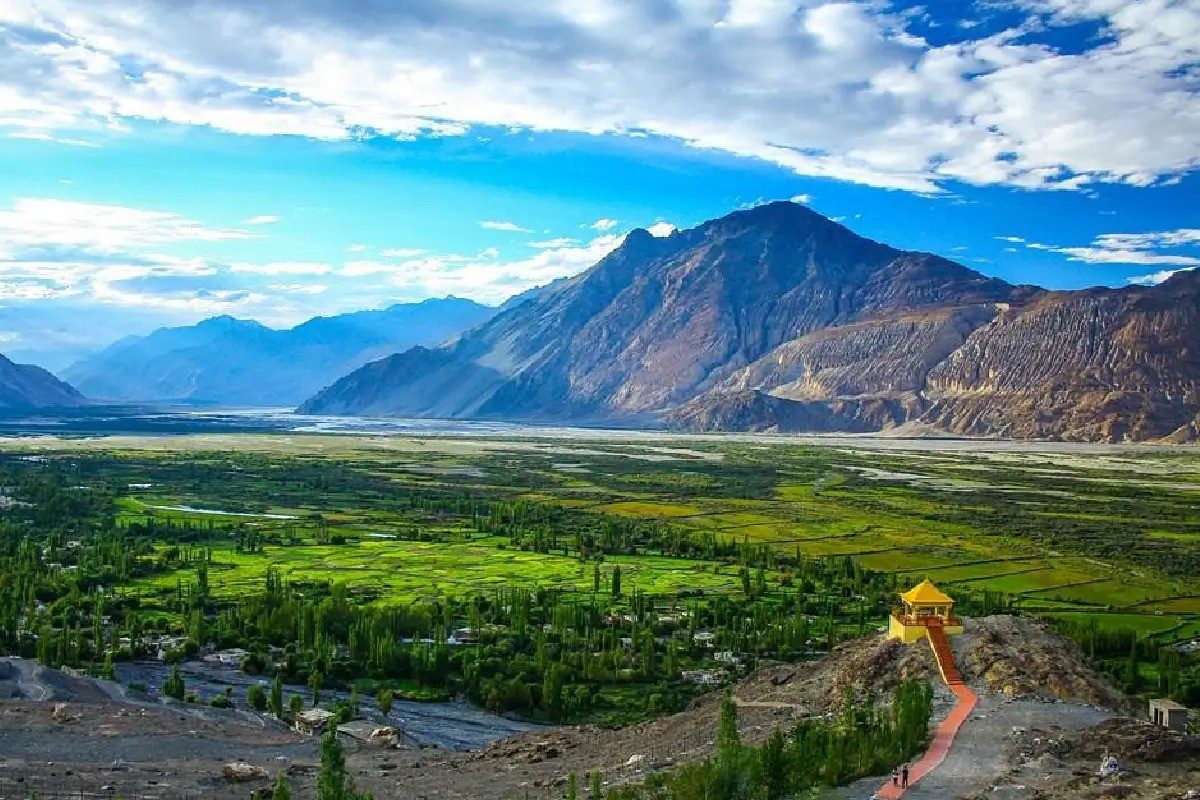
“The Nubra Valley trek was one of the most enriching experiences of my life. The mixture of landscapes and cultures made every day on the trail feel new. I felt like I was walking through history.”
— Alicia Ross, Teacher, USA
Best Time to Trek the Nubra Valley
Ideal Trekking Seasons in Ladakh: When to Go
The best time to trek Nubra Valley is during the summer months, from June to September. During this period, the weather is relatively mild, and the snow at high passes has mostly melted, making it easier to traverse the trails. The skies are clear, allowing for stunning views of the surrounding mountains.
If you are keen on seeing the vibrant beauty of the Nubra Valley’s landscape, the monsoon season (July to August) transforms the valley into a blooming paradise. The greenery contrasts beautifully with the desert-like terrain and rocky slopes.
Trekking During the Shoulder Seasons: Lesser-Known Advantages
While most people visit Nubra Valley during the summer, trekking during the shoulder seasons—late May or early October—offers distinct advantages. Fewer crowds mean more solitude and a better chance to connect with nature and local cultures. October, in particular, brings in cooler weather and an incredible contrast of fall colors as the valley transitions into winter. However, trekking at this time requires good preparation for cold weather conditions.
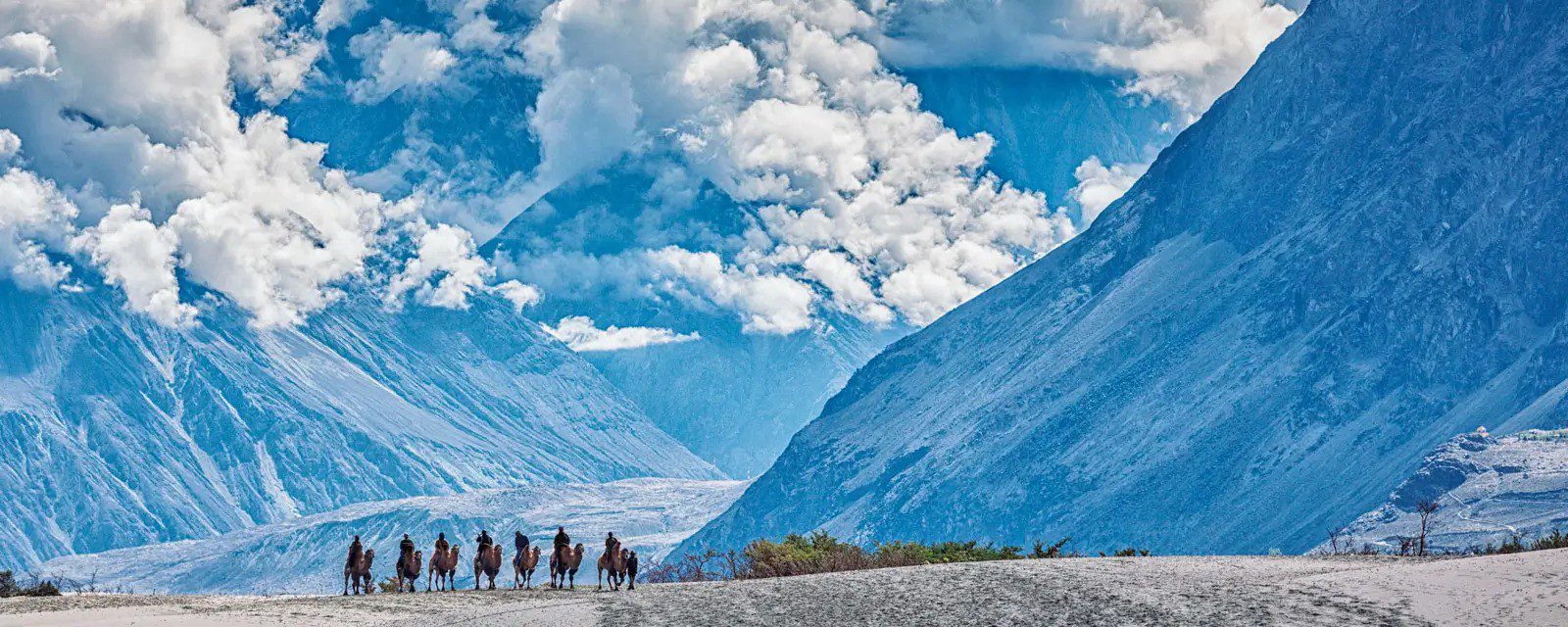
How to Reach Nubra Valley for Trekking Adventures
Leh to Nubra Valley Trek: How to Get There
Your Nubra Valley adventure starts in Leh, the capital of Ladakh, which is accessible by air from major Indian cities. From Leh, trekkers typically cross the famous Khardung La Pass, one of the highest motorable roads in the world, at an altitude of 5,359 meters. This pass connects Leh to Nubra Valley, making the journey an adventure in itself.
“Crossing the Khardung La was breathtaking. The altitude hit me, but the views were worth every moment. The descent into Nubra Valley felt like stepping into another world.”
— Marco Alvarez, Engineer, Spain
Getting Trekking Permits for Nubra Valley
Foreign nationals and Indian tourists alike need an Inner Line Permit (ILP) to visit Nubra Valley. These permits are easily obtainable from the Leh DC office or through local tour operators. Remember to carry multiple copies, as they may be required at various checkpoints.

Nubra Valley Trekking Routes and Itineraries
Popular Trekking Routes in Nubra Valley
Nubra Valley offers a range of trekking routes, from shorter day hikes to multi-day treks. Some of the most popular routes include:
- Diskit to Hunder Trek: A scenic, easy trek through desert terrain, famous for its sand dunes and Bactrian camels.
- Sumur to Panamik Trek: This moderate trek offers stunning views of the Nubra River and opportunities to soak in the Panamik hot springs.
- Trek to Ensa Monastery: A cultural trek that takes you through villages and offers panoramic views of the valley.
Off-the-Beaten-Path Treks in Nubra Valley
For the more adventurous, there are lesser-known routes that take you deeper into the valley. The trek from Hunder to Turtuk is a great option for those looking to explore Ladakh’s remote villages and interact with Balti communities. Another hidden gem is the Trek to Yarab Tso Lake, an oasis-like lake considered sacred by the locals.
Day-by-Day Itinerary for a Nubra Valley Trek
Here’s a sample itinerary for a 5-day Nubra Valley trek:
| Day | Route | Highlights |
|---|---|---|
| 1 | Leh to Diskit | Visit Diskit Monastery |
| 2 | Diskit to Hunder | Explore sand dunes and camel safari |
| 3 | Hunder to Sumur | Panoramic views, cultural immersion |
| 4 | Sumur to Panamik | Soak in hot springs, visit remote villages |
| 5 | Panamik to Yarab Tso Lake | Trek to the sacred lake, peaceful surroundings |
What to Expect During Your Trek in Nubra Valley
Nubra Valley Landscapes and Natural Wonders
As you trek, the changing landscapes are nothing short of extraordinary. The Hunder sand dunes, located at the confluence of the Shyok and Nubra rivers, present a surreal contrast against the towering Himalayas. The Nubra River meanders through lush valleys, while on the horizon, snow-capped peaks glisten. This unique combination of desert, rivers, and mountains makes Nubra Valley a trekker’s dream.
Cultural Experiences: Monasteries and Local Villages
One of the most enriching aspects of trekking the Nubra Valley is the cultural immersion. Visit ancient monasteries like Diskit Monastery, famous for its 32-meter Maitreya Buddha statue overlooking the valley. In villages like Sumur and Turtuk, you’ll find people living simple, traditional lives. Don’t miss the opportunity to engage with locals, who often invite trekkers for tea and share stories about life in the valley.
“The people of Nubra Valley are what truly made my trek unforgettable. Their kindness and hospitality were unmatched, and I learned so much about their traditions.”
— Ravi Kumar, Photographer, India
Wildlife and Flora Along the Nubra Valley Trek
Though the valley appears barren at first glance, Nubra is home to a surprising diversity of flora and fauna. Keep an eye out for blue sheep and Himalayan marmots. In terms of flora, you’ll trek through patches of wildflowers and groves of willow and poplar trees, especially around villages.
Preparing for Your Nubra Valley Trek
Fitness and Acclimatization: What You Need to Know
Trekking in Nubra Valley requires good fitness, as many trails traverse rugged terrain and high altitudes. Acclimatization is crucial since some of the trekking routes, particularly those crossing Khardung La, reach altitudes above 5,000 meters. To avoid altitude sickness, it’s essential to spend a few days in Leh before starting your trek.
Essential Packing List for Nubra Valley Treks
Packing for Nubra Valley means being prepared for extreme weather conditions. Here’s a list of essentials:
- Trekking boots (waterproof)
- Warm layers (temperatures can drop dramatically at night)
- Trekking poles
- Sunscreen (the sun at high altitudes can be intense)
- Water purification tablets
- Portable oxygen cylinder (optional but useful at high altitudes)
- First-aid kit
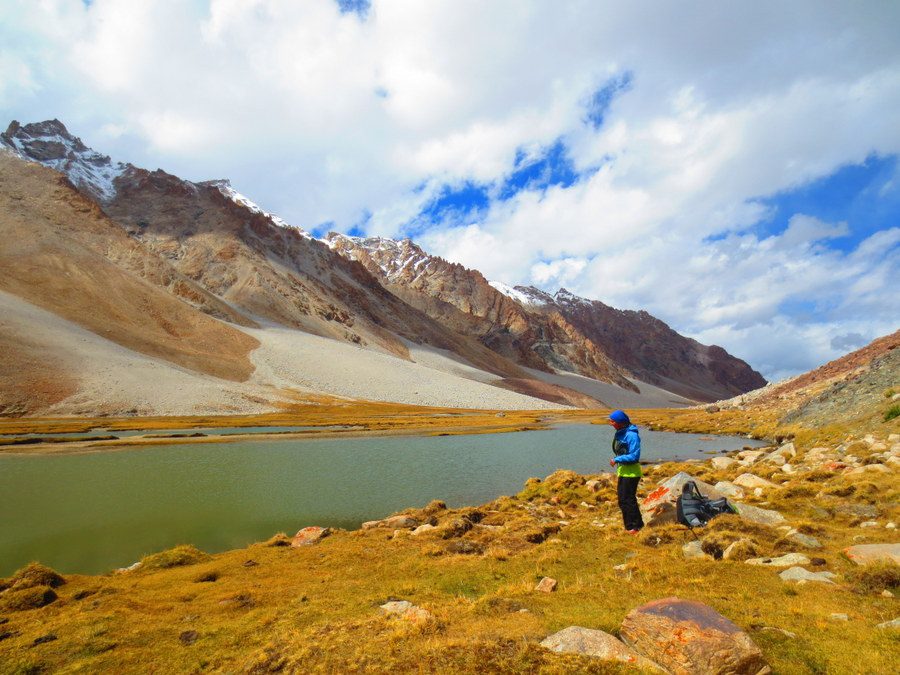
Nubra Valley Trekking Experiences
Personal Stories from the Nubra Valley Trekking Trail
Many trekkers leave Nubra Valley with more than just memories. They take away stories of adventure, challenge, and spiritual connection. Whether it’s navigating a high-altitude pass or spending a night under the stars in a remote campsite, the experiences are often transformative.
“Nubra Valley isn’t just a trek; it’s a journey of self-discovery. The isolation and beauty of the place make you reflect on life in a way few other experiences can.”
— Lena Becker, Journalist, Germany
Camping Under the Stars in Nubra Valley
Camping in Nubra Valley is one of the trek’s highlights. As the sun sets and the cold Himalayan night descends, you’ll find yourself under a dazzling blanket of stars. Whether you’re at a campsite near the Hunder sand dunes or a more remote spot near Yarab Tso Lake, the night sky will leave you speechless.
Tips for a Safe and Enjoyable Trek
Staying Safe on the Nubra Valley Trek
Safety should always be a priority. Ensure you have a solid plan, sufficient supplies, and are well-acclimatized. Hiring a local guide is highly recommended, especially if you’re trekking off the beaten path.
Sustainable Trekking Practices in Nubra Valley
It’s important to practice Leave No Trace principles while trekking in Nubra Valley. This includes packing out all your trash, using designated campsites, and respecting the local environment and wildlife.
Conclusion: Embark on a Nubra Valley Adventure
Trekking the Nubra Valley is a once-in-a-lifetime adventure that offers everything from dramatic landscapes and cultural insights to personal growth and outdoor challenges. If you’re ready to explore Ladakh’s hidden oasis, Nubra Valley is waiting for you.
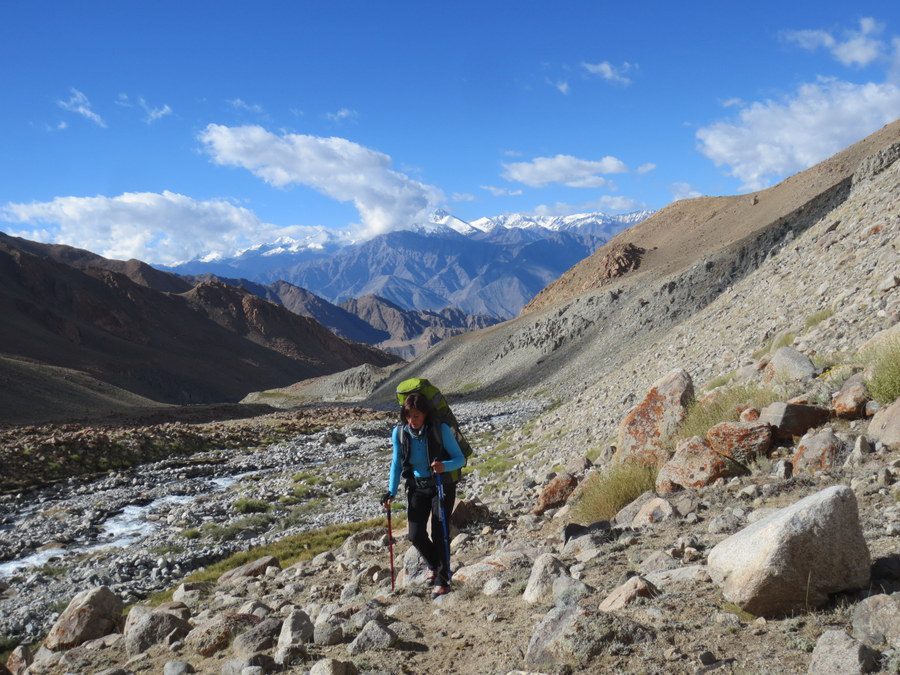
FAQs About Trekking the Nubra Valley
How Difficult is the Nubra Valley Trek?
The difficulty varies depending on the route, but many treks are moderate. However, high-altitude passes like Khardung La can be challenging.
Do I Need a Guide for the Nubra Valley Trek?
While you can trek independently on some routes, hiring a guide is recommended, especially for remote or lesser-known trails.
What Permits Do I Need for Trekking in Nubra Valley?
An Inner Line Permit (ILP) is required for both Indian and foreign tourists.
What’s the Best Time to Visit Nubra Valley?
The best time to trek Nubra Valley is between June and September when the weather is mild and most routes are accessible.
Can I Camp While Trekking in Nubra Valley?
Yes, there are designated camping spots, and many trekking routes offer fantastic camping opportunities.
How Can I Prepare for High-Altitude Trekking in Ladakh?
Spend at least 2–3 days in Leh to acclimatize, stay hydrated, and trek slowly to avoid altitude sickness.

